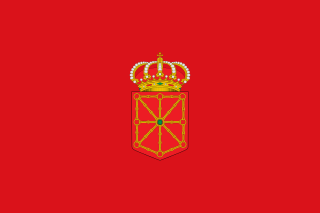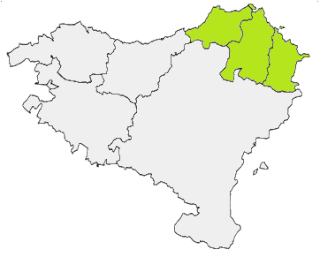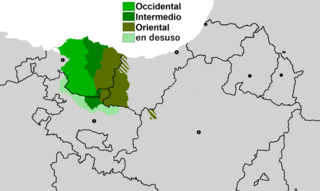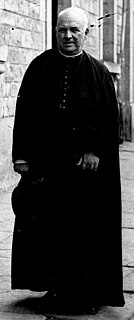
Basque , also known as euskara, is a language spoken by Basques and others of the Basque Country, a region that straddles the westernmost Pyrenees in adjacent parts of northern Spain and south-western France. Linguistically, Basque is a language isolate. The Basques are indigenous to, and primarily inhabit, the Basque Country. The Basque language is spoken by 28.4% (751,500) of Basques in all territories. Of these, 93.2% (700,300) are in the Spanish area of the Basque Country and the remaining 6.8% (51,200) are in the French portion.

Navarre, officially the Chartered Community of Navarre, is a foral autonomous community and province in northern Spain, bordering the Basque Autonomous Community, La Rioja, and Aragon in Spain and Nouvelle-Aquitaine in France. The capital city is Pamplona. The present-day province makes up the majority of the territory of the medieval Kingdom of Navarre, a long-standing Pyrenean kingdom that occupied lands on both sides of the western Pyrenees, with its northernmost part, Lower Navarre, located in the southwest corner of France.

Zazpiak Bat is a heraldic nickname for the Basque coat of arms which includes the arms of the seven provinces mentioned, stressing their unity. It was designed by the historian Jean de Jaurgain in 1897 for the Congrès et Fêtes de la Tradition basque celebrated at Saint-Jean-de-Luz.

Labourd is a former French province and part of the present-day Pyrénées Atlantiques département. It is one of the traditional Basque provinces, and identified as one of the territorial component parts of the Basque Country by many, especially by the Basque nationalists.

Gipuzkoa is a province of Spain and a historical territory of the autonomous community of the Basque Country. Its capital city is Donostia-San Sebastián. Gipuzkoa shares borders with the French department of Pyrénées-Atlantiques at the northeast, with the province and autonomous community of Navarre at east, Biscay at west, Álava at southwest and the Bay of Biscay to its north. It is located at the easternmost extreme of the Cantabric Sea, in the Bay of Biscay. It has 66 kilometres of coast land.

Euskaltzaindia is the official academic language regulatory institution which watches over the Basque language. It conducts research, seeks to protect the language, and establishes standards of use. It is known in Spanish as La Real Academia de la Lengua Vasca and in French as Académie de la Langue Basque.
The Basque alphabet is a Latin alphabet used to write the Basque language. It consists of 27 letters.

The French Basque Country, or Northern Basque Country is a region lying on the west of the French department of the Pyrénées-Atlantiques. Since 1 January 2017, it constitutes the Basque Municipal Community presided over by Jean-René Etchegaray.
Iberian languages is a generic term for the languages currently or formerly spoken in the Iberian Peninsula.

Biscayan, sometimes Bizkaian is a dialect of the Basque language spoken mainly in Biscay, one of the provinces of the Basque Country of Spain.
Upper Navarrese is a dialect of the Basque language spoken in the Navarre community of Spain, as established by linguist Louis Lucien Bonaparte in his famous 1869 map. He actually distinguished two dialects: Meridional and Septentrional. However, the southern varieties became extinct early in the 20th century mainly after becoming absorbed by Northern Spanish or Aragonese. So documentation of the Meridional subgroup is rendered impossible. It is unknown whether the extinction was due to Francisco Franco's fierce suppression of Basque culture.

Navarro-Labourdin or Navarro-Lapurdian is a Basque dialect spoken in the Lower Navarre and Labourd (Lapurdi) former provinces of the French Basque Country. It consists of two dialects in older classifications, Lower Navarrese and Labourdin. It differs somewhat from Upper Navarrese spoken in the Peninsular Basque Country.

Standard Basque is a standardised version of the Basque language, developed by the Basque Language Academy in the late 1960s, which nowadays is the most widely and commonly spoken Basque-language version throughout the Basque Country. Heavily based on the literary tradition of the central areas, it is the version of the language that is commonly used in education at all levels, from elementary school to university, on television and radio, and in the vast majority of all written production in Basque.

Bertsolaritza[berˈts̺olaɾits̻a] or bertsolarism is the art of singing extemporaneously composed songs in Basque according to various melodies and rhyming patterns. Bertsos can be composed at a variety of occasions but are performed generally by one or various bertsolaris onstage in an event arranged for the purpose or as a sideshow, in homage ceremonies, in benefit lunches and suppers, with friends or at a competition. Such a sung piece of composition is called a bertso, the person who sings it is called a bertsolari and the art of composing bertsos is called bertsolaritza in Basque. Traditionally these were sung by men but there is an increasing number of young female bertsolaris today.
Etxeberria is a Basque language placename and surname from the Basque Country in Spain and France, meaning 'the new house'. It shows one meaningful variant, Etxeberri, and a number of later spelling variants produced in Spanish and other languages. Etxebarri(a) is a western Basque dialectal variant, with the same etymology. Etxarri (Echarri) is attested as stemming from Etxaberri.

Although the first instances of coherent Basque phrases and sentences go as far back as the San Millán glosses of around 950, the large-scale damage done by periods of great instability and warfare, such as the clan wars of the Middle Ages, the Carlist Wars and the Spanish Civil War, led to the scarcity of written material predating the 16th century.

Basque dialects are linguistic varieties of the Basque language which differ in pronunciation, vocabulary and grammar from each other and from Standard Basque. Between six and nine Basque dialects have been historically distinguished:

Resurrección María de Azkue was an influential Basque priest, musician, poet, writer, sailor and academic. He made several major contributions to the study of the Basque language and was the first head of the Euskaltzaindia, the Academy of the Basque Language. In spite of some justifiable criticism of an imbalance towards unusual and archaic forms and a tendency to ignore the Romance influence on Basque, he is considered one of the greatest scholars of Basque to date.

Alavese is an extinct dialect of the Basque language spoken formerly in Álava, one of the provinces of the Basque Country of Spain. The modern-day communities of Aramaio and Legutio along the northern border with Biscay do not speak the Alavese dialect but a variant of the Biscayan dialect instead and while overall some 25% of people in Álava today are Basque speakers, the majority of these are speakers of Standard Basque who acquired Basque via the education system or moved there from other parts of the Basque Country.

16th-century Basque literature begins with three authors considered classics: Joan Perez de Lazarraga, Bernard Etxepare and Joanes Leizarraga. In the manuscript of the first of them, discovered in 2004, the influence of the traditional court lyric, the Italian novela pastoril and the popular Basque templates can be observed. In the case of Etxepare, often compared to the Archpriest of Hita, the influence of French literature has been mentioned. Regarding Leizarraga, translator into Basque of the New Testament and other works on religious themes, he stands out for his attempt to find a unified language—a concern of many of the later authors—and for his use of cultured verbal forms and compound sentences, nonexistent in written literature up to that time.














